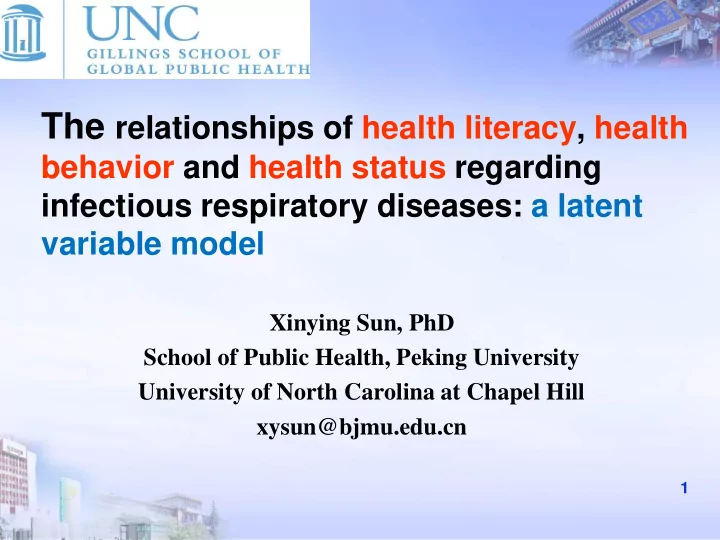

The relationships of health literacy, health behavior and health status regarding infectious respiratory diseases: a latent variable model Xinying Sun, PhD School of Public Health, Peking University University of North Carolina at Chapel Hill xysun@bjmu.edu.cn 1
Background What is health literacy? Health literacy is the degree to which individuals can obtain, process, understand and communicate about health related information needed to make informed health decisions. 5th Annual Health Literacy Research Conference 2
Health outcomes Health Health status • Age • Preventive behavior literacy • Education • Access and utilization of • Language barrier health care 1,2 • Occupation and • Obtain • Self-care 1 • Increase income • Process mortality • Patient-provider • Prior knowledge 3 • Communicate • Increase interaction 1,2 • Capabilities 3 hospitalization • Understand • Management of health and • Poorer control illness 2 Socioeconomic of chronic characteristics diseases Health behavior and management 1,Paasche-Orlow 2007; 2, von Wagner 2009; 3, McCormack 2012 3 5th Annual Health Literacy Research Conference
Methods Sample Measurement Data analysis Latent variable analysis was used by Lisrel 8.70. 5th Annual Health Literacy Research Conference 4
DaTong, Shanxi Beijing Shenzhen, Guangdong 5th Annual Health Literacy Research Conference 5
Multi-stage stratified cluster sampling (3222 residents) Region Beijing Shanxi Guangdong Area City(local residents) Village(migrant population) Survey setting hotels, building sites, assembly shops, communities, factories, government employment medical examination organizations, other institutions centers 5th Annual Health Literacy Research Conference 6
Questionnaire Socio- • Age, gender, ethnicity, marital status demographic • Education, occupation, income characteristics • Different types of infectious respiratory Prior knowledge diseases • Prevention methods • Preventive behaviors (washing hands, wearing a Behaviors and face mask, sneezing, room ventilation) actions • Treatments for infectious respiratory diseases • Frequency of sickness and seeing a doctor due to upper respiratory infection Health status • Degree of severity for each sickness and the duration 7 5th Annual Health Literacy Research Conference
Skill-based health literacy measurement 16 stimuli materials(including 3 pieces of audio or video to test communication literacy) WHO, China CDC, Chinese Center of Health Education Involving the distribution of epidemics, immunization programs, early symptoms, means of disease prevention and individual’s preventative behavior, use of medications and thermometers, treatment plans, etc 5th Annual Health Literacy Research Conference 8
Newspaper for print-prose literacy
Print-document literacy Picture of pill case for question about expiry date
Table for print-quantitative literacy Hospital level Starting pay line Reimbursement ratio Designated hospitals at 80 RMB 80% township/village-level (first level) Local designated hospitals at 200 RMB 60% district/county-level (second level) Nonlocal designated hospitals at 500 RMB 60% district/county-level (second level) Designated hospitals at 1000 RMB 50% municipality-level (third level) 5th Annual Health Literacy Research Conference 11
Reliability of the instrument Cronbach α Variables Items Prior knowledge 12 0.662 Health behavior 23 0.688 Health status 13 0.623 Health literacy 30 0.863 Print-prose 5 0.568 Print-document 8 0.664 Print-quantitative 6 0.531 Oral 6 0.624 Internet 5 0.964 Sun et al. BMC Public Health, 2013,13:261 12 5th Annual Health Literacy Research Conference
Construct Validity of Health literary Measurement Sun et al. PLOS ONE, 2013,8(5):e64153 13 5th Annual Health Literacy Research Conference
latent variable model Original results of 5th Annual Health Literacy Research 14 RMSEA=0.076 GFI = 0.918 Conference
Health literacy model Age .356 .041 .209 Health Health Education Health literacy Behavior status .337 Knowledge 5th Annual Health Literacy Research Conference 15
Conclusion This model explains the determinants of health literacy and the associations between health literacy and health behaviors well. Education and prior knowledge has positive, strong and direct effect on health literacy. Age has negative, strong and direct effect on health literacy. Health behavior is influenced by age and prior knowledge positively but weakly by health literacy. Health behavior is an important factor to health status. 5th Annual Health Literacy Research Conference 16
Implication and limitation This model is at the individual level. To extend the scope of health literacy beyond the individual. Limited by the project background (infectious respiratory diseases) To test the feasibility of the model in regards to other diseases and aspects of health. 5th Annual Health Literacy Research Conference 17
Acknowledgement China-US Collaborative Program on Emerging and Re-emerging Infectious Diseases (5U2GGHH000018-02). CDC China Office and RTI international for their support and valuable comments. Health care workers in Beijing, Shenzhen and Datong for their help in data collection. Thank you for your attention. 5th Annual Health Literacy Research Conference 18
Recommend
More recommend